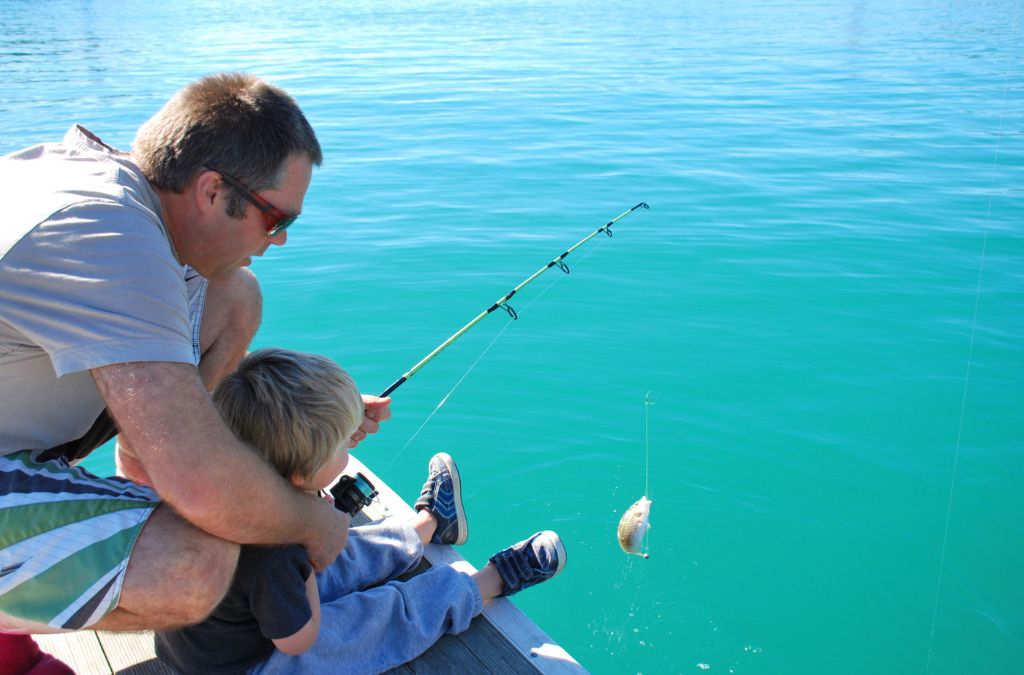Most kids love to fish. So, the first time you take kids fishing is both thrilling and challenging. There are some difficulties with fishing such as baiting the hook and casting a line. However, spending time outdoors, forming bonds and having fun are all possible when you take kids fishing.
Your level of preparation will determine how successful a fishing trip could be. And that doesn’t equate to the number of fish caught! There are risks involved whenever you are near water and your child may not share your love for fishing. It is important to have everything you need before you set out to go fishing with your kids.
We have compiled expert advice to help you share your passion and ensure you all enjoy the first fishing trip with your kids.
1. Determine A Good Spot To Take Kids Fishing
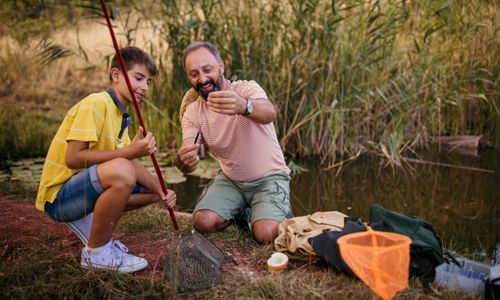
Search for a fishing location with a large catchment area that is family-friendly.
Ponds, rivers, lakes and reservoirs are all options. In fact, our expert fishermen suggest that you start small.
Visit a location where kids can reel in small fish on their own, such as bluegill or crappie.
Your kids will have an amazing experience and be extremely excited as a result. Hopefully, this will make them want to go fishing again.
If you are looking at taking kids fishing in a boat, ensure their safety and fish in shallow, calm bays. Of course you must always wear a life-vest when out on the water.
If they go a long time without catching a fish, kids can quickly lose interest. Therefore, don’t be reluctant to try new places; move to another area of the lake or to the other side of the pier.
A castable fish finder that you can hurl into the water is another option. Even if you are fishing from the shore, this will show you whether there are any fish in your intended fishing location.
2. Use Simple Equipment To Take Kids Fishing
Children learn best when they are engaged. So, get child-sized equipment that your children can use successfully. It should be small enough for them to handle without strain.
Take into consideration a 5-foot rod, an 8–10 pound fishing line, split shots, and a bobber. Kids benefit from using bobbers because they can easily see when there has been a bite.
Purchase a simple tackle box for them to store their essential fishing gear in. Store extras of each item in case anything breaks or is lost.
When kids are learning to fish they might tangle their lines and lose their hooks. Without having spares, these incidents could cut short your fishing trip.
Our expert anglers suggest using live bait when you take kids fishing because it holds their attention.
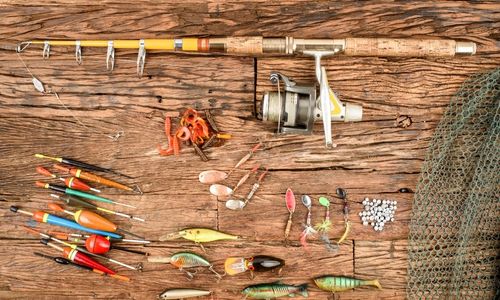
3. Pack Plenty Of Snacks And Water
Children cannot concentrate when they are hungry. Therefore, bring along enough food to keep them satisfied. Make sure to pack a healthy breakfast or lunch and their preferred snacks, as this will help them stay focused.
When you take kids fishing, take a snack break every 30 to 60 minutes to keep them more engaged.
Drinking plenty of water is critical with any outdoor activity. Carry enough water and make sure the kids drink it so they don’t become dehydrated.
You can also bring a juice box to supplement their water intake.
4. Keep It Brief When You Take Kids Fishing
When children engage in the same activity for an extended period of time, they quickly become bored. To ensure that your kids are engaged the entire time and want to go fishing again, schedule your trip for a few hours.
Telling them when they’ll be back will keep them interested until the end of the trip. Aim for a maximum of two hours of fishing time, and increase the time as your children’s interests and comfort levels grow.
To avoid the hot sun, schedule your trip for early or late in the day. These also happen to be the best times to go fishing as fish are more active.
5. Put Fun First

Adults may take fishing seriously, but children will need some wriggle room.
Celebrate any catches and concentrate on providing an unforgettable experience.
Be patient and optimistic regardless of the outcome.
If you notice your children becoming bored, encourage them to take a break. You could spend some time exploring the shoreline, skipping stones or searching for insects.
6. Teach Kids The Fundamentals Of Fishing
Teaching kids good fishing techniques on their first outing gives them the best chance of catching a fish. Also, show them that ethical anglers observe the law and care about environmental preservation.
Find out what the current fishing laws are for your area and that you have an appropriate fishing license. Include learning the proper water safety techniques before you take kids fishing.
To educate them about the different species that are present at your fishing location, do some research online before you go.
7. If You Don’t Get A Catch, Have Backup Plans
Even though you selected the best fishing spot, there are some days when you might not catch anything. Children may find this frustrating, especially if you don’t have a backup strategy.
Bring a net and ask the kids to look for minnows in shallow water. Be accommodating to children who want to play games like rock-throwing, worm-catching or other activities near the water.
Carry playthings like a skipping rope or bug-catcher to keep them occupied.
8. Maintain Safety When You Take Kids Fishing
Kids love to catch fish, but it is also important to keep them safe.
They should wear appropriate clothing for the weather, including light long-sleeved shirts in summer. Bring hats and sunscreen for sun protection and bug spray to guard against bites.
Even when playing along the shore, make sure your children are wearing safety gear like reflective jackets.
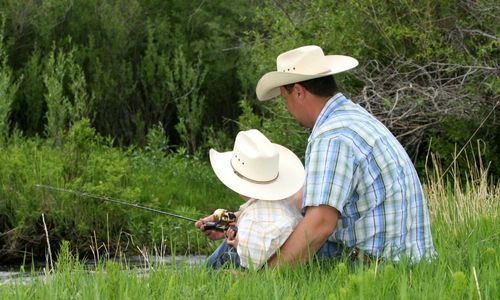
Have a change of clothes on hand in case they get wet – you are around water! And bring a first aid kit to treat minor wounds.
To reduce the chance of injury, think about purchasing barbless hooks.
9. Finish The Journey In Style
End the trip on a positive note if you want your kids to want to go fishing again. You can do something fun but not too extravagant, like stop for ice cream on the way home or visit a nearby park.
Regardless of whether they managed to catch any fish, the kids will feel satisfied with their day.
Enjoy the fishing party for longer by playing fishing-themed games and reading up on fishing techniques at home.
Learning how to tie knots, playing the game “Go Fish,” or visiting an aquarium are examples of possible activities.
10. Don’t Give Up When You Take Kids Fishing
Children will remember fishing if you leave them with a sense of excitement and anticipation for the next one.
If you aren’t having success, shake things up by switching bait or moving to a new location. Prepare your children for adulthood by teaching them patience and persistence.
Use the time together to build special bonds by talking about things that you have in common. Explain why fish will “take the bait” and what they need to do to encourage that.
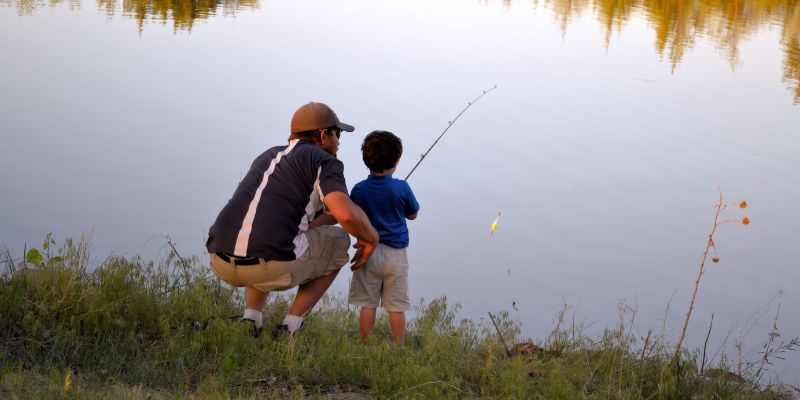
Summary
When you take kids fishing, it is important to plan first. Make sure that you have the right equipment for their age and experience. Bring extras in case of a snag or broken line plus healthy food, snacks and plenty of water.
Have a first aid kit, protective clothing, life vest, sunscreen and bug spray ready to keep kids safe. Plan some activities for your kids when the fishing is slow.
Fishing can be a fun activity for the whole family if done properly. Ensure everyone has a good time and plan ahead when you take kids fishing!
Our super author here at Famous Parenting and an absolute wealth of knowledge. She has studied many topics including creative writing, psychology and journalism but her real passion lies in raising her 3 children. Between working from home, homeschooling her youngest 2 children and navigating the world of teenagers she is a guru for parents.

